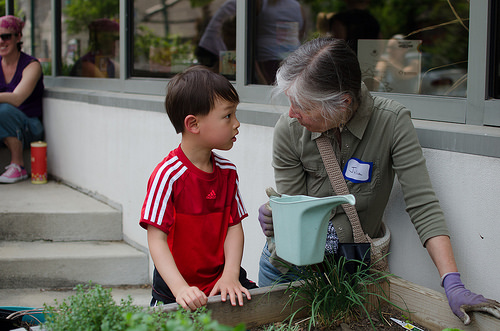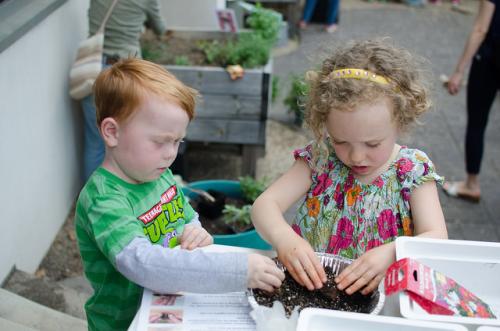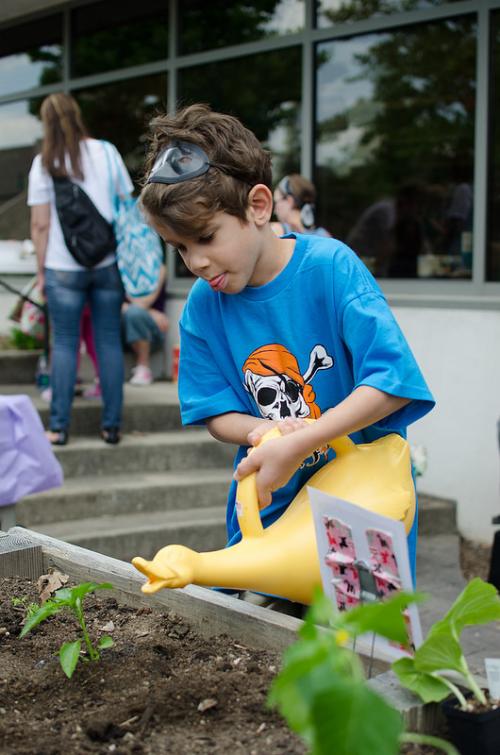For the month of August, we’re highlighting our two Wacom Intuos Pro pen tablets. We have one medium and one large sized tablet to use with digital drawing, painting, and design software. They check out in Level Up for two hours with a library card. See below a bunch of information on how to use these tablets to make the most of your designs.
Think Library: Blog
Ready, set, go! Start reading the nominees for the Eliot Rosewater Book Award and vote for your favorite. You just might choose the winner!

Summer is a great time to get outside and get your hands dirty. We did just that at our Generations Gardening Together program in May and again, earlier this month, at Little Makers. Ginny and friends got green with a fun spring/summer activity, creating seed bombs!

Seed Bombs are small balls made from clay, seed, and dirt that will explode with beautiful flowers when planted or thrown into dirt areas. They’re great for exploring nature and present an opportunity for learning. Even more important, they’re fun and can incorporate some of Every Child Ready to Read’s five daily practices, such as” playing” and “talking.” Why stop there? Add in a song or a reading and writing activity to get the full five practices! Try the fingerplay "My Garden" performed by our own librarian, Mary and one of the recommendations on our Gardening Books for Kids list.

What You’ll Need :
- Potting soil
- Red clay
- Flower seeds (we used wildflower seeds)
What To Do :
- Knead the clay to soften it.
- Once the clay is moldable, flatten and shape the clay into a disc shape.
- On top of the clay disc, add ½ teaspoon of potting soil and ¼ teaspoon of flower seeds.
- Fold the clay inward, keeping the soil and seeds from spilling out. Mold the clay into a ball around the soil and seeds.
- In a bowl, mix some soil and seeds together.
- Roll your seed bomb through the soil and seeds. Try to get an even covering of soil and seeds on the clay.
- Gently pat the soil and seeds into the clay to incorporate them into the clay ball.
- Toss the seed bomb wherever you’d like plants to grow!



This is a hard book to categorize. Is it a dual biography? A history of a region? An environmental paean to a place? A literary memoir of the West? A road book to both grand and despoiled places?
It’s all of the above and more. Gessner began the book as a tribute to two western writers who have inspired him: Edward Abbey and Wallace Stegner. Gessner went to grad school in Colorado and fell in love with the southwest. Abbey and Stegner became his heroes and teachers, although not literally—he learned through their writing.
He compares the more revolutionary-seeming Abbey who broke laws (trashed earth-moving machines to stop development and threatened to blow up dams) with the more straight-laced Stegner.
The start of school is right around the corner. Try one of these books to get yourself in the school mood. Set in boarding schools, magical schools, and regular high schools - these stories are guaranteed to make you feel slightly more studious.
Miwanzo is the Swahili word for “beginnings.” In this fascinating fictional biography, this word could stand for so many things: Beryl Clutterbuck’s family arriving in Africa from England when she was a child of four; the young girl establishing a close emotional bond with the local native families, known as Kipsigis; the first time she trained a thoroughbred on her own; and the first time she piloted a plane.
What an exciting life Beryl led. Beryl was one of those women who pushed against the boundaries of convention to fully partake in life.
She became the first female licensed racehorse trainer in Africa and the horses under her care won many races. She became an early bush pilot in Africa and the first woman aviator to fly across the Atlantic from east to west.
Seraphina by Rachel Hartman is a fast paced, beautifully imagined fantasy. Seraphina is a talented musician working at the royal court, but she also has a dangerous secret she has to keep - she is half dragon. In the world of this novel dragons can inhabit their natural form or a human form called a Saar. While in their human form they have forged a treaty with Seraphina's home country of Goredd, but it is a tenuous peace with both sides still holding deep prejudices against each other.
Seraphina finds herself thrust into the very heart of conflict. The story is adventurous, mysterious, political, and romantic. Seraphina is a character to root for and one who will find her way into readers' hearts. Pick up this fabulous book (or it's sequel Shadow Scale) and let it transport you to a new world.
Thanks to all or our Level Up patrons for visiting the library's new digital creativity space! We've been up and running for four months now and the support and input from patrons has been amazing. The staff of Level Up has been working hard to enhance their digital skills to provide the best possible service to Level Up patrons. Another way we would like to assist patrons of Level Up to get the most from our services is by beginning to highlight some of our amazing pieces of gear, software, and gadgets. We'll provide a more in depth look at one piece of technology every month. We'll provide links to the product manual, tutorials, and other informative articles to help patrons get comfortable with all Level Up has to offer. Below is our first installment. Check it out!
The Akai MPK 49 MIDI Controller is available in Audio Production Studio 2, which can be reserved online through D!BS.

The Akai MPK 49 is a 49-key, semi-weighted keyboard with 12 backlit percussion pads, assignable knobs and faders, and more. With the MPK 49, thousands of sounds can be controlled through Level Up’s audio software (Logic Pro X, Ableton Live 9, and Propellerhead Reason 8)—from common instruments like guitars, basses, and drums to more unusual instruments like mellotrons, zithers, and gamelans. The controller’s ultra-sensitive keys and pads ensure that audio sounds realistic and organic. Eight knobs and faders allow assignment for up to 64 track parameters when using 4 banks to make recording and mixing a more hands-on experience. Visit mcpl.info/dibs to reserve Audio Production Studio 2 and start making music with the Akai MPK 49!
Here are some helpful links:
http://www.akaipro.com/product/mpk49
Akai MPK 49 Overview (YouTube Video)
Check back next month for a new Level Up highlight!
There sure are a lot of books about the End of the World these days; Dystopian novels have been very popular in our rapidly changing present and uncertain future. I would consider this one "literary" fiction, in the sense that the novel isn't really about the genre, but rather uses it as a device that focuses more on its descriptive language and sense of place. This book is set specifically in the Toronto/Great Lakes area as it evokes a sense of wonder about our civilization in its retrospective loss of everything. The story weaves back and forth between several characters before, during, and after an outbreak of "The Georgia Flu" (the Eastern European kind). As any good, modern plague story, airplane travel is quickly identified as the initial means of pandemic. This is not a fast paced, action-driven story (as most of the dystopias I have read), but rather revels in its lack of immediacy. There is no reason to rush, because we have been exposed to the outcome; there is no longer any hustle and bustle of the modern world.
The book jacket suggests this is a cross between Cormac McCarthy and Joan Didion. I can see those inspirations in the author's writing, but it really isn't as blunt or lyrical as either of those great writers. Yet, seeing the comparison in itself is a compliment to the thoughtfulness put into the characters. The story is a bit too disjointed to every really care enough about any particular person, for me, but its detailed authorial observations kept me intrigued throughout (like how gasoline can "go bad" after a certain amount of time or the simple lack of something like a newspaper, in a world without electricity, can break down all institutional communication). The book is less suicide-inducing than The Road and less grief-stricken than The Year of Magical Thinking, but worth a read if you want a well-reviewed book from last year that no longer has a holds waiting list.
If this isn’t the year for a summer vacation, why not have a stay-cation with these books and delight in some armchair travel to places you may never have a chance to visit otherwise.
Don’t Let’s Go to the Dogs Tonight by Alexandra Fuller
Mom says, "Don't come creeping into our room at night."
They sleep with loaded guns beside them on the bedside rugs.
She says, "Don't startle us when we're sleeping."
"Why not?"
"We might shoot you."
"Oh."
So begins Alexandra Fuller’s memoir Don’t Let’s Go to the Dogs Tonight, a memoir of her childhood in growing up in Rhodesia (now Zimbabwe) during civil war. Born in England, Fuller immigrated to Rhodesia with her parents when she was a toddler. It’s hard to imagine why her parents thought moving to Rhodesia during a civil war was a good idea, but both had ties to the continent. Her father moved to Kenya as a young man and her mother lived in Kenya during the twilight of its empire days. Fuller never gives the impression they were imperialists but settlers. Fuller’s dad was often absent-fighting for “White rights” in Africa. At home, her mom managed her depression mostly with alcohol- “We're all mad, but only I have the certificate to prove it.”
Life was hard. The family moved from one poor performing tobacco farm to another. Fuller focuses on stories of family life while moving around Rhodesia with the Rhodesian Civil War framing the background. For example, Fuller’s first school picture is include and in it she is holding an Uzi. But for every mention of the war, there’s also a tale of life in Africa. From planting during the spring to reclaiming a farmhouse from the encroaching jungle to even the sounds, Fuller paints such a detailed picture of the landscape that you can almost feel you’re there.
For more about Fuller’s family and life in Africa read: Scribling the Cat and Cocktail Hour Under the Tree of Forgetfulness.
Not every story has a clear beginning, middle and end. Here are three that challenge the traditional definition of "novel."
The Lover's Dictionary by David Levithan
The title of The Lover’s Dictionary describes exactly what is inside this novel: a story of a relationship told through alphabetical dictionary entries describing the large and small events that shape a relationship. While the first entry describes a scene from the first meeting, the rest of the novel does not follow linearly. We learn of how the unnamed couple falls in love, events that cause tension, milestones in their relationship and vignettes about love.
For example:
I, n.
Me without anyone else.
Just announced: the Library of Congress appointed Juan Filipe Herrera as our latest national poet laureate. The child of migrant farm workers, Herrera is the first Hispanic poet laureate. As a child, he traveled up and down the state of California with his parents, and later attended UCLA with the help of a grant for disadvantaged youth.
At the age of 21, Herrera was inspired by the debut book by Puerto Rican poet, Victor Hernandez Cruz.
He also writes children's books and those for young adults. Check out our list of his titles.
If you’ve read any of Kazuo Ishiguro’s novels, you know that not only can he write beautiful prose but that he also weaves interesting, compelling stories.
For an author who has written about widely divergent themes: life among the British gentry and serving classes (The Remains of the Day) and a group of schoolchildren being farmed for body parts (Never Let Me Go), his latest takes a leap into entirely new directions.
Call it an on the road/historical/Arthurian/ attempt-to-find-and-slay-a-giant-novel. This giant, who lives in Britain after the Anglo Saxon wars, spumes up dense clouds that cause people to lose their memories.
Beatrice and Axl, two very old Britons, find themselves denied candles in their village, forced to spend their nights in the cold dark, and are treated shabbily in other ways. They decide to leave and attempt a long arduous journey to see their only child, a son, who has not returned to the village for many years. Beatrice suffers from an unnamed illness that makes her very frail but she’s determined to see their son again.
Because of the endless polluted mists, neither she nor Axl can remember why their son left, or why he has not returned. Axl vaguely recalls an argument just before they parted, so the old couple want to make amends.
In one village where they spend the night, the residents mob a young boy who has a weird bite on his skin. They are so angry that Axl fears for the boy's life, and rushes to his rescue, but the mob attacks him instead. After leaving this village they find this boy again accompanied by a Saxon. Long ago, Axl fought against the Saxons, and the country is just starting to heal from the vicious wars.
Axl and Beatrice agree to travel with them, because the Saxon promises to help the couple reach their destination. They feel sorry for the boy too, but they are also leery of his bite.
While trying to cross a bridge, guards with swords detain them. When the Saxon sees them coming, he concocts a plan to play the fool. He also advises the couple to say that the boy has come with them. So the Saxon lolls his head, wags his tongue while the guards draw swords and prepare to spear him. But his disguise succeeds at least until the guard realizes later that the boy might be the boy bitten by the dragon, and chases them again.
The party also meets elderly Sir Gawain, one of the knights or Arthur’s Round Table. The king has commanded him to slay the buried giant. At one point, the Saxon accuses him of not really trying to kill the beast. Why else would it still be alive?
The couple decide to visit a monastery even though it is out of the way and high on a mountain because they heard a monk there offers excellent counseling. But alas, the monastery was not what they thought. Around its windows and parapets, huge ravens swarm eager for bites of flesh. There is also a large tower that looks burnt, and has a suspicious platform on which it looks like battles have been fought, and enemies thrown off. Later the Saxon discovers a weird torture device in an out-building. And yes, those hungry ravens continue to batter the hatches.
Ishiguro weaves history, Arthurian legend, and medieval fear of those different from us into a wonderful parable, but at heart, this is a story of a long marriage, how two people survive both the rough and calm seas of life, trying to bridge their differences, and caring for each other despite mistakes, arguments, hard feelings and the chaos of a world gone mad around them.
For an entirely different take on England long ago, try Geraldine Brooks' Year of Wonders: a novel of the plague.
This double biography of two famous first cousins, both belonging to the famous Roosevelt clan, brings the early 20th century to life in both Washington DC and New York and gives us a fascinating peak into two strong women’s lives, both of whom married or were born into politics.
Eleanor Roosevelt and her first cousin Alice were born just eight months apart. Alice came from the Republican Oyster Bay branch of the family and Eleanor from the Democratic Hyde Park (NYC) branch. Not only did they differ in political and social outlooks, but they even pronounced their last name differently. Alice’s family said Rose—evelt. And Eleanor’s pronounced the same name as Ruse-evelt.
Are you looking for a book that you can't put down? One that raises the hair on your arms and doesn't leave your mind for days? Or, are you just looking for a recommendation for your Adult Summer Reading guide? One of these may be for you!
Set in Stalinist Soviet Union, former war hero and current MGB agent Leo Demidov works long hours tracking down and arresting citizens suspected of political crimes. Leo knows most of them are innocent, just as he knows he can easily be on the other side of the interrogation table. Sent to investigate the death of a co-worker’s child, Leo is upset because he has more important work to do. His frustration levels grow when the child’s parents won’t stop insisting that their child has been murdered. In the Soviet Union in 1953 there is no crime, and certainly no murder. Meanwhile, Leo’s jealous co-work plants seeds of doubt into their superior’s minds, and when Leo refuses to denounce his wife as a traitor, they both become targets of the State. While on the run, Leo encounters more evidence that there is a serial killer on the loose-one that is targeting children and he is determined to put a stop to it.
This fast paced thriller will leave you on the edge of your seat. Several twists and tunrs only add to the suspense. Though the book deals with sensitive topics, they are not described in gorey detail. Smith instead focuses on the fear the Soviet system instilled it it’s people. Read it now before it hits the big screen this fall!
If you enjoyed Child 44, then read the series other two books- The Secret Speech and Agent 6.

